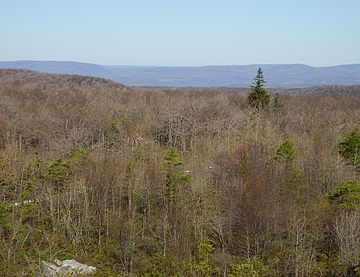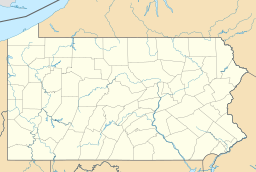Negro Mountain facts for kids
Quick facts for kids Negro Mountain |
|
|---|---|

View west from Negro Mountain highpoint
|
|
| Highest point | |
| Elevation | 3,213 ft (979 m) |
| Geography | |
| Location | Somerset County, Pennsylvania / Garrett County, Maryland, U.S. |
| Parent range | Allegheny Mountains |
| Topo map | USGS Markelton, Meyersdale (PA) Quadrangle |
| Climbing | |
| First ascent | Unknown |
| Easiest route | Drive up |
Negro Mountain is a long ridge of the Allegheny Mountains, stretching 30-mile (48 km) from Deep Creek Lake in Maryland, north to the Casselman River in Pennsylvania, United States. The summit, Mount Davis, is the highest point (3,213 feet) in Pennsylvania. Negro Mountain is flanked by Laurel Hill to the west and Allegheny Mountain to the east.
Geography and climate
The mountain is flattish in appearance due to its location on the Allegheny Plateau, so its prominence is of low relief. The mountain retains its elevation above 3,000 feet (910 m) for much of its length, especially in Pennsylvania. The Negro Mountain Tunnel, built for the South Pennsylvania Railroad, is abandoned and was never used. The Mount Davis Natural Area on the Mountain is located within the Forbes State Forest and many trails take hikers throughout this alpine landscape.
Weather on the mountain is fierce, frost can occur at any time of the winter and winds and snowstorms are common. Near the summit in Pennsylvania, the trees are stunted and circular rock formations from frost heave can be readily seen.
History
Details behind the naming of Negro Mountain are not precisely known and a number of local stories have circulated in the past. Most of these are first noted in print in publications of the mid-19th to early 20th Century. The various stories seem to share, however, a couple of elements. One is that of a band of white soldiers or hunters skirmishing with Native Americans on the mountain during colonial times. The other is the presence with the whites of an African-American companion – variously named "Nemisis" [sic] or "Goliath" indicating his great strength or size – who accompanied the whites and died valiantly during the fight.
The best documented version of the story takes place during the French and Indian War, in the year 1756, when frontiersman Colonel Thomas Cresap is known to have led a force against French and Indian forces on the mountain. A member of his force, a free black man, was killed in the battle in a manner described by Cresap's published account in the Pennsylvania Gazette of June 17, 1756. The mountain became known as "Negro Mountain" in his honor. While many of the later, 19th century, histories contain embellishments that contemporary accounts cannot confirm, it is known that Cresap set forth on his incursion in May, 1756 accompanied by a band of frontiersman and woodsmen he had gathered, plus elements of the 1st Virginia Regiment, 17th company 'Rangers', under the command of Lt. Gist.
Another version of the story has a Captain Andrew Friend on a hunting trip on the mountain with a few companions. The party was attacked by Native Americans and during the ensuing skirmish, an African-American servant of Friend was gravely wounded and died the following morning on the mountain. Again, the mountain where he died defending the life of his master was named in his honor.
Yet another version, this time from local family lore, tells of:
John Hyatt, one of the early settlers, [who] was a native of Maryland. He came with several others, accompanied by a number of slaves, to Turkey-Foot [Township] soon after the settlement began. While crossing the Negro mountain, a party of Indians fired upon them and mortally wounded one of the negroes, the strongest man in the company. A piece of a hollow log was found and placed over the negro to shelter him. Throwing it off, he said, "Save yourselves and never mind me; I shall die soon." It is said that Negro Mountain took its name from this circumstance.
The Cresap version is supported by the fact that Cresap is known to have written an account of such an expedition for Benjamin Franklin's Pennsylvania Gazette of June 17, 1756 mentioning that "an old Negro presented his gun at [the Indians]". The Maryland Gazette had already described the same expedition on June 10, 1756, mentioning that a "free Negro" had been killed in action during the fighting. It may be additionally noted that Andrew Friend and Thomas Cresap each drew pay, in 1766, from Captain Chapline's company of the Maryland Militia for frontier services. Additionally, John Hyatt is known to be the son-in-law of Andrew Friend, marrying his daughter Susannah. There is no record that he or Andrew Friend ever owned slaves, and as Pennsylvania residents, were unlikely to have been importing them. After the published accounts of Cresap's military action in 1756, the first recorded reference to the geographical landmark as Negro Mountain was in 1775.
There are yet other sources that claim the mountain was named because of the black shadow it casts at certain times of the day, as observed from adjacent ridges. "Negro" is the Spanish word for "Black", so if this were the case, the name would have nothing to do with the African American race, but instead was likely chosen by Spanish explorers who were known to have traversed the area during the 15th and early 16th centuries, and observed a similar phenomenon that earned the Blue Ridge Mountains their name.
Images for kids



